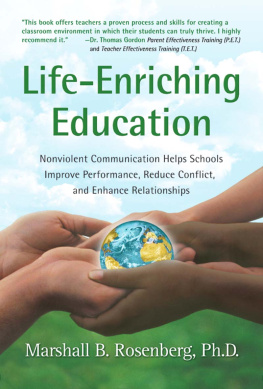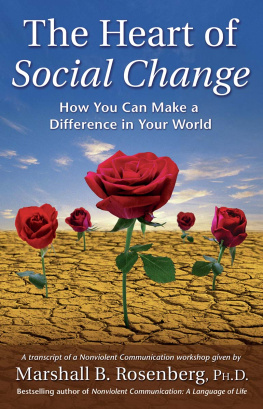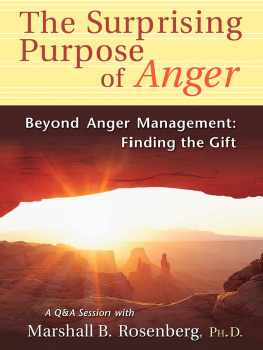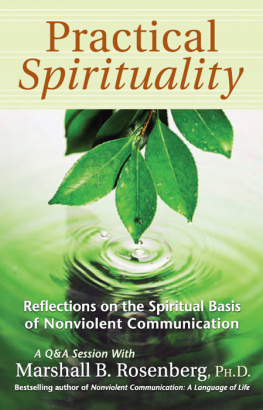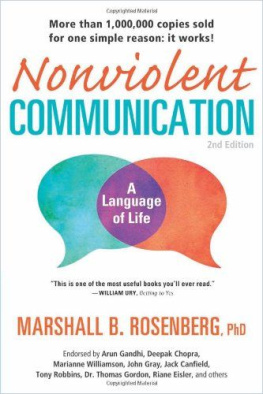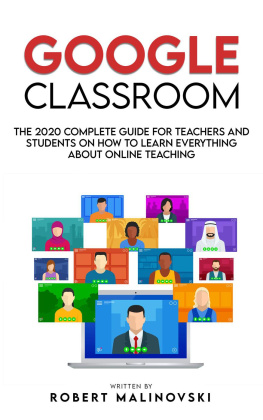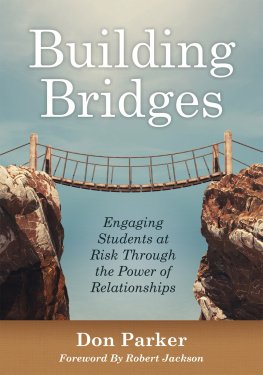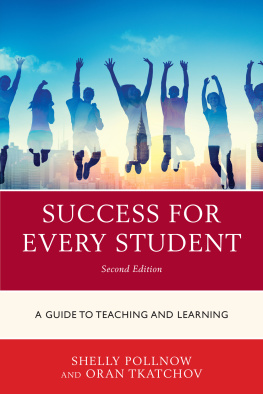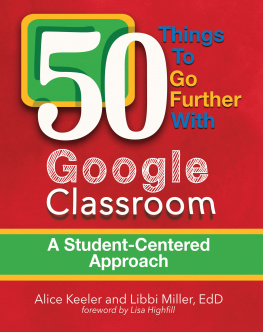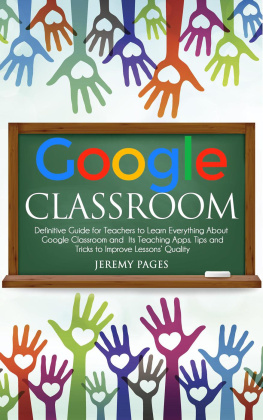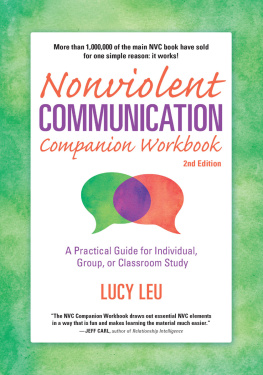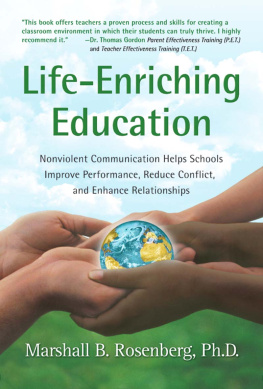
Life-Enriching Education
Nonviolent Communication Helps Schools Improve Performance,
Reduce Conflict, and Enhance Relationships.
Copyright 2003 by Marshall B. Rosenberg, Ph.D.
Published by PuddleDancer Press
All rights reserved. No part of this book may be reproduced by any mechanical, photographic, or electronic process, or in the form of a photographic recording, nor may it be stored in a retrieval system, transmitted or otherwise copied for public or private use without the written permission of the publisher.
Requests for permission should be addressed to:
PuddleDancer Press, Permissions Dept.,
P.O. Box 231129, Encinitas, CA 92023-1129
Fax: 1-858-759-6967 Email:
Author: Marshall B. Rosenberg, Ph.D.
Editor: Kathy Smith
Project Director: Jeanne Iler
Index: Phyllis Linn, INDEXPRESS
Cover and Interior Design: Lightbourne
Manufactured in the United States of America
10 9 8 7 6 5 4 3
ISBN: 978-1-892005-05-2
Library of Congress Cataloging-in-Publication Data
Rosenberg, Marshall B.
Life-enriching education : nonviolent communication helps schools improve performance, reduce conflict, and enhance relationships / by Marshall B. Rosenberg.-- 1st ed.
p. cm.
ISBN 1-892005-05-0
ISBN 978-1-892005-05-2
1. Teacher-student relationships. 2. Affective education. 3. Communication in education. I. Title.
LB1033.R66 2003
371.1022--dc21
2003011055

Contents

Acknowledgments
I am grateful to master teacher Bill Page for giving me, more than thirty years ago, the opportunity to clarify how I would like to see teachers and students working together.
I am also grateful to JoAnne Anderson and Tom Shaheen, school administrators in Rockford, Illinois, at that time, for giving me the chance in the late 1960s to participate with them in creating schools that functioned in harmony with my values.
These experiences along with the writings of John Holt, Ivan Illich, John Gatto, and Alfie Kohn deepened my awareness of the politics of education, and further increased my hunger to contribute to radical changes in education. More recently, Riane Eisler writings on partnership and dominator education have been influential in this context.
How grateful I am also to my colleagues Miri Shapiro in Israel, Nada Ignjatovic in Serbia, Vilma Costetti in Italy, and Rita Herzog in the United States for demonstrating what each of us can do to transform schools that teach Domination into schools that provide Life-Enriching learning opportunities.
And finally I would like to express deep gratitude to Kathy Smith, with additional help from Rita Herzog and Gary Baran, for editing what I have written and translating my university English into readable English.

Foreword by Riane Eisler
M any of us recognize that fundamental change in education is urgently needed. We recognize that most present educational systems are not preparing children to meet the unprecedented challenges of the twenty-first century. We recognize that real educational reform is essential if todays and tomorrows children are to live in a more peaceful, just, and sustainable world.
In this book, Marshall Rosenberg describes key elements of what he calls life-enriching education: an education that prepares children to learn throughout their lives, relate well to others and themselves, be creative, flexible, and venturesome, and have empathy not only for their immediate kin but for all of humankind.
Enriching lifeexpanding our minds, hearts, and spiritsshould be the goal of education. Unfortunately, traditional education has often constricted rather than expanded the human mind, heart, and spirit. It has interfered with our natural curiosity and joy in learning, suppressed inquisitiveness and critical thinking, and modeled uncaring and violent behaviors.
Fortunately, today most Western schools no longer use violence against children, as in the old motto spare the rod and spoil the child. But they still use other teaching methods designed to prepare people to unquestioningly obey orders from abovebe it from their teachers in school, supervisors at work, or rulers in government.
The curriculum, also, often presents violence and domination as normal, even desirableas in history classes where children must memorize the dates of battles and wars, and literature classes where they are assigned epics in which violent conquest is idealized as manly and heroic. The structure of schools is also generally still one of top-down rankings in which education is something done to students rather than with students.
This type of educational process, content, and structure is appropriate for what I have called the dominator or domination model of societywhere families, workplaces, tribes, and states are organized into rigid rankings of domination ultimately backed by fear and force. It is not an education appropriate for democratic, equitable, and peaceful societiessocieties orienting to what I call the partnership model, and Rosenberg calls a life-enriching structure.
Obviously there has already been considerable movement away from the domination model, at least in some world regions. Had there not been, we could not be talking of fundamental educational change without risking severe consequences, even deathas was the case for any free thought and speech not so long ago during the European Middle Ages, and is still the case in many places today.
But this forward movement has not been linear. It has not only been fiercely resisted every step of the way; it has also been punctuated by regressions to the domination model. We are experiencing such a regression worldwide todaya regression to more, rather than less, inequality, violence, and human and environmental exploitation and domination. This is why the application of Rosenbergs Nonviolent Communication methods to education is so important, so urgent, and so timely.
Marshall Rosenberg is known worldwide as a pioneer in nonviolent conflict resolution. He has dedicated the last forty years of his life to developing and applying Nonviolent Communication as a tool for relations in which each person is treated with empathy and caring. In this book, he shows us how to use this method in schools. He also shows its effectiveness in preparing young people to work together, resolve conflicts nonviolently, and contribute to both their own and others well-being in empathic and caring ways.
One of the most notable characteristics of Rosenbergs work is this focus on caring, empathy, and nonviolencecharacteristics that in domination-oriented cultures are relegated to those who are excluded from social governance: women and effeminate men. Marshall recognizes that these are precisely the characteristics we have to nurture in both boys and girls, and shows how we can do this through tested and effective educational methods that allow young people to experience partnership in action.
Next page
